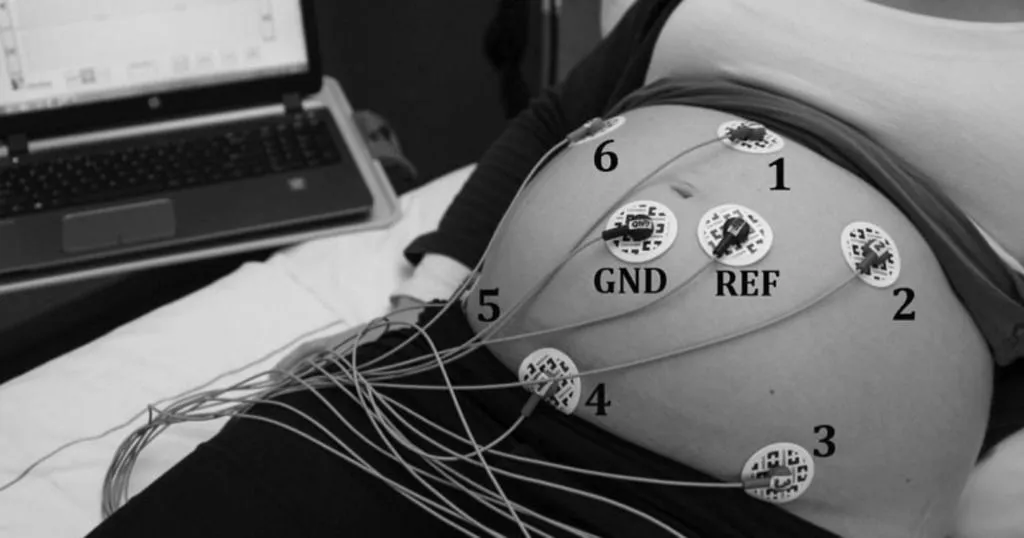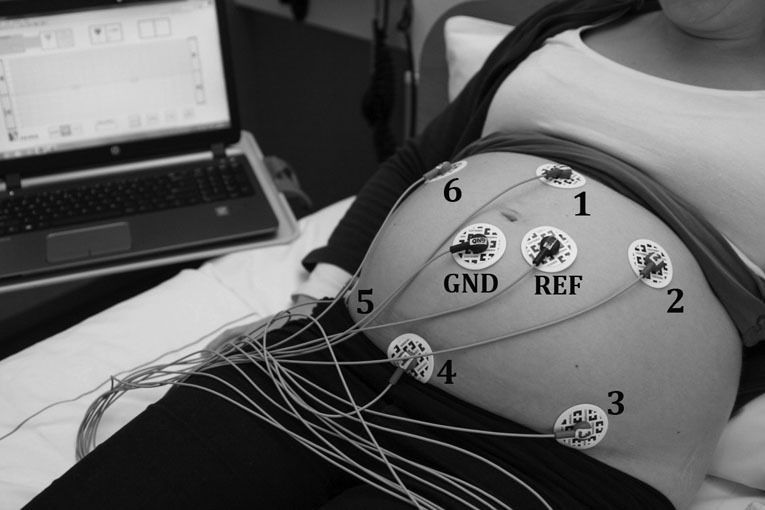Fetal electrocardiography
The results of the fundamental research reported in Kim Verdurmen's thesis show that fetal ECG is a technique that is still developing but has shown to have multiple promising prospects, both during pregnancy and labour.
Posted by
Published on
Mon 01 May. 2017
Topics
| ECG | Healthcare | Heart Rate |

In electrocardiography (ECG) the electrical activity of the heart is measured. In adults this is performed with self-adhesive electrodes on the chest. From research and adult cardiology we know that heart rate, heart rate variability and other parameters derived from the ECG can give us a lot of information.
Fetal heart rate registration via the pregnant belly
During pregnancy and labour, it is important to have information regarding the fetal condition. Besides the perception of fetal movements by the mother and ultrasonography, we can make a registration of the fetal heart rate via the pregnant belly. Since the fetus is safely protected within the womb, it is inaccessible for direct measurements during pregnancy. Nowadays, heart rate registration is performed as “cardiotocography”; registration of the heart rate is performed with a Doppler-ultrasound based system, detecting heartbeats as a reflection from moving parts of the fetal heart. Simultaneously, contractions of the womb are registered. However, cardiotocography is prone to signal loss, inadvertent maternal heart rate monitoring, signal artefacts and it does not provide the heart rate as a beat-to-beat signal.

Multi-lead recordings increase the signal quality
A fetal ECG can be obtained non-invasively with electrodes on the maternal abdomen. In our research, eight electrodes are used, of which six fetal ECG channel electrodes, one reference and one ground electrode. For each of the six fetal ECG electrodes, the voltage difference between a recording electrode and the reference electrode is calculated. By using multi-lead recordings we can combine different leads in order to increase the signal quality and to allow recombination of leads to reconstruct the standard Einthoven leads. The chances of recording good quality fetal ECG signals in at least one of the electrodes is maximised by spreading the electrodes over the womb. A portable prototype recording and storing device is used to process the recordings. Several filters are applied and the ECG of the mother is removed by weighted averaging of maternal ECG segments. By spatially combining the signals of the six fetal ECG channels, the signal-to-noise ratio is enhanced. Following detection of the R-peaks in the fetal ECG, a beat-to-beat fetal heart rate signal is created.
Several applications of fetal ECG
With this fetal ECG signal, we have more information regarding the fetal condition. During my PhD, our research group studied several applications of fetal ECG;
- Detection of congenital heart diseases (CHD). Fetal ECG seems to be a promising diagnostic tool to complement in the screening for CHD. It reflects the intimate relation between the conduction system and the structural morphology of the heart, and it is particularly helpful in detecting the electrophysiological effects of cardiac anatomical defects (e.g. hypotrophy, hypertrophy and conduction interruption).
- Study the effect on heart rate and heart rate variability of drugs that are administered during threatened preterm birth. Since heart rate variability is one of the most reliable indicators of fetal wellbeing, it is very important to know the exact influence on drugs that are frequently administered in obstetric care. In our research, we described the effects of two groups of drugs.
- During labour, when the water has been broken and there are a few centimetres of dilation, the fetal ECG can be registered directly with an electrode attached to the fetal head. In order to detect oxygen shortage during delivery, “ST monitoring” can be applied. In ST monitoring, the fetal ECG is analysed to detect signs of fetal distress and the monitor can give an alarm. However, in clinical practice a lot of false alarms are encountered. Our research group developed a hypothesis describing how these false alarms might be caused, proved this hypothesis and proposed a solution for this problem.
The results of the fundamental research reported in my thesis show that fetal ECG is a technique that is still developing but has shown to have multiple promising prospects, both during pregnancy and labour.
By Drs. K.M.J. Verdurmen - PhD: “The prospects of fetal electrocardiography during pregnancy and labour” - Defence Technical University Eindhoven, 5th July, 16:00h.
Related Posts

The impact of health information technology on doctor-patient interaction

What is simulation-based training?
